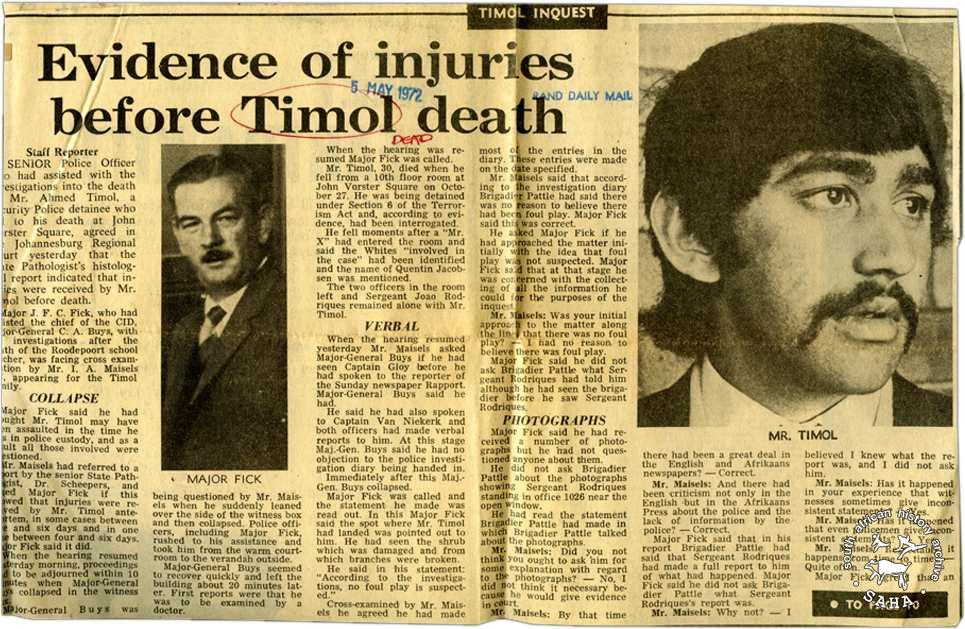
The reopening of the Timol Inquest and the implications for future transitional justice in South Africa
Ahmed Timol was an anti apartheid activist and a member of the South African Communist Party, who after being arrested died in custody at John Vorster Square police station after falling from the 10th floor. In the original inquest into his death, Timol was said to have been sitting calmly and then when left ‘’unattended” with one policemen in the room, he asked to go to the bathroom and then he jumped out of the window to his death. The inquest in 1972 established the police were not at fault. After many years of fighting the Timol family persuaded the National Prosecuting Authority to reopen the inquest based on new evidence having come to light.
Highlights of what has emerged thus far in the ongoing inquest at the Pretoria High Court:
- The police used brutal torture techniques, including suffocation, sleep deprivation, a variety of beating methods and psychological abuse and possibly including LSD doping.
- The forensic pathologists’ interpretation of the original post mortem report is that Timol had wounds inflicted from up to 12 hours before. These injuries effectively meant that Timol would not have been able to easily walk or jump out of the window.
- A head injury, a fractured skull, which he had sustained likely left him either unconscious or in a very compromised state. The implication of the two pathologists’ testimonies are that Timol was barely alive when he allegedly jumped to his death.
- Kenneth Boffard, a trauma specialist, was surprised that the police covered Timol’s body, moved it to the 9th floor before certifying him dead, as at that time the police were worried about being liable for additional injury in the 1970s and usually waited for an ambulance.
- As yet, little new information has been revealed from the testimony and cross questioning of Joao Rodrigues who was allegedly the last to see Timol alive.
Future implications of the reopening of this inquest for others

During the Truth and Reconciliation Commission (TRC) hearings, testimonies were given about the death of Ahmed Timol. However, the TRC process offered no closure as there was no ‘truth’ revealed. There has been significant criticism around the failures of the TRC to redress past human rights violations.The reopening of the inquest into the death of Ahmed Timol more than forty years later presents an opportunity for families to open or reopen inquests where loved ones that were detained by the police died in suspicious circumstances.
The Mabelane family, similar to the Timol family also had a member of their family allegedly jump to their death from the 10th floor of John Vorster Square. Matthews Mabelane even wrote a farewell note on the inside of his clothing that he believed the police were planning to push him to his death. Umkhonto we Sizwe (MK) Military Veterans have also called for an inquest into the death of Ashley Kriel. Following suit, the Luthuli family wants to reopen the inquest of Albert Luthuli’s death to mention a few. Between 1960 and 1994, at least 87 political detainees died in mysterious circumstances in custody (TRC Legal Hearing, Judiciary, 1997).
Is this the beginning of a new wave of transitional justice or accountability for South Africa’s past?
In its search for justice to address the gross human rights violations perpetrated during Argentina’s military dictatorship in the 1970s, the country used its domestic courts to try officials. These cases were heard 30 – 40 years on. This is a similar time frame to the current inquest in South Africa. This may be a beginning of a journey where the TRC failed in its efforts of redress and where the judiciary can play a part in providing closure to some of South Africa’s darkest moments in history. Perhaps, it even presents an opportunity for new narratives to emerge.

Between Life and Death: Stories from John Vorster Square
Between Life and Death: stories from John Vorster Square is a virtual walk through the police cells on the 10th floor of South Africa's most notorious police station, where the security force reigned in apartheid South Africa.
SAHA has also developed an Educators guide to go through material relating to detention at John Vroster.
SAHA has many interview transcripts of different detainees that were detained in John Vorster Police station.
[Click for more information]
References
http://sabctrc.saha.org.za/hearing.php?id=56324&t=timol&tab=hearings
http://www.iol.co.za/capeargus/news/call-for-probe-in-ashley-kriel-death-10562733
http://www.news24.com/SouthAfrica/News/mabelane-family-hopes-ahmed-timol-death-inquest-will-open-doors-20170713
http://city-press.news24.com/News/a-call-for-inquest-into-chief-albert-luthulis-death-20170723
https://www.timeslive.co.za/news/south-africa/2017-07-25-expert-surprised-apartheid-police-moved-ahmed-timols-body/
http://www.africanrhetoric.org/pdf/10%20Truth%20versus%20impunity%20-%20Post-transitional%20justice%20in%20Argentina%20-%20S%C3%A9vane%20Garibian.pdf
https://www.ictj.org/news/decades-after-dictatorship-argentinas-courts-still-lead-fight-accountability







